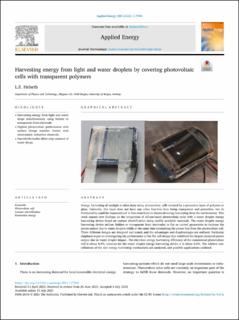Harvesting energy from light and water droplets by covering photovoltaic cells with transparent polymers
Journal article, Peer reviewed
Published version

Åpne
Permanent lenke
https://hdl.handle.net/11250/2768880Utgivelsesdato
2021Metadata
Vis full innførselSamlinger
Sammendrag
Energy harvesting of sunlight is often done using photovoltaic cells covered by a protective layer of polymer or glass. Currently, this layer does not have any other function than being transparent and protective, but its functionality could be improved and in fact contribute to electrical energy harvesting from the environment. This work reports new findings on the integration of silicon-based photovoltaic solar with a water droplet energy harvesting device based on contact electrification using readily available materials. The water droplet energy harvesting device utilizes hidden or transparent front electrodes in flat or curved geometries to increase the power output due to water droplets while at the same time minimizing the power loss from the photovoltaic cell. Three different designs are designed and tested, and the advantages and disadvantages are outlined. Particular emphasis is put on investigating the performance of the flat cell design that exhibited the largest electrical power output due to water droplet impact. The electrical energy harvesting efficiency of the commercial photovoltaic cell is about 4.4%, whereas for the water droplet energy harvesting device it is about 0.6%. The relative contributions of the two energy harvesting mechanisms are analyzed, and possible applications outlined.
